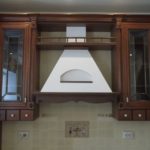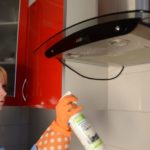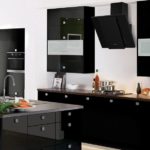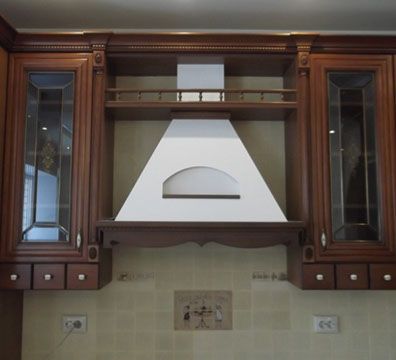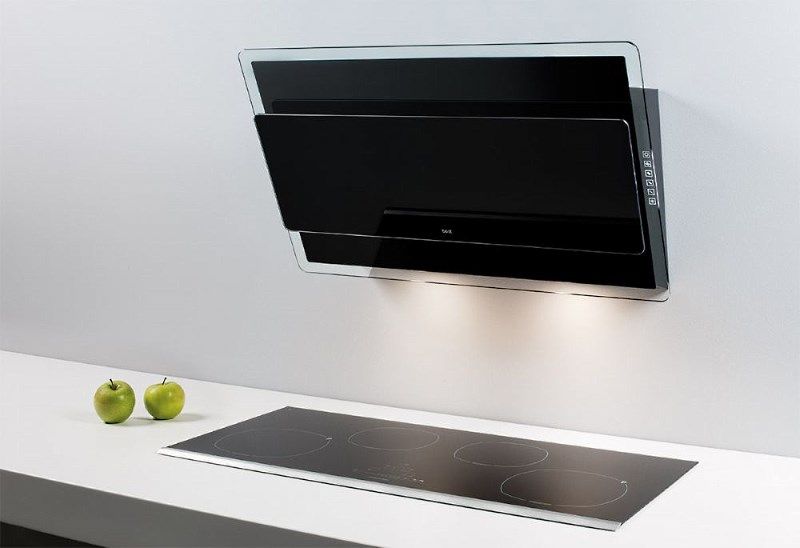How to correctly position the socket under the hood in the kitchen
 The correct location of the outlet for the hood affects the appearance of the kitchen and the ease of use of ventilation equipment. At the stage of designing and installing kitchen furniture, it is most convenient to choose a place for connection. In reality, you have to deal with different situations, including installing sockets after repairs and arranging furniture.
The correct location of the outlet for the hood affects the appearance of the kitchen and the ease of use of ventilation equipment. At the stage of designing and installing kitchen furniture, it is most convenient to choose a place for connection. In reality, you have to deal with different situations, including installing sockets after repairs and arranging furniture.
The content of the article
Which socket is suitable for the hood in the kitchen?
The easiest way to connect the hood is to use an extension cord. But a network cable walking around the kitchen work area will create constant discomfort. It will interfere with the use of part of the desktop. To avoid negative emotions, the socket is installed next to the hood.
First of all, you need to understand the type and type of electrical appliance that needs to be installed. Sockets are:
- with or without grounding;
- overhead or built-in;
- with additional functions;
- special purpose.
REFERENCE! For safety of use, modern kitchen hoods have grounding in the form of a third connection wire or a plug with a special contact. This type of equipment requires the use of grounded sockets.
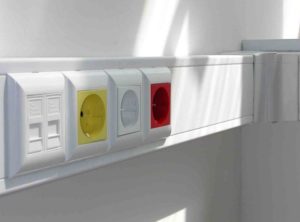 There is no need for additional functions that allow you to turn off an electrical appliance using a toggle switch or highlight the connection point of the plug. Therefore, power sources with additional and special functions are not used when connecting the hood.
There is no need for additional functions that allow you to turn off an electrical appliance using a toggle switch or highlight the connection point of the plug. Therefore, power sources with additional and special functions are not used when connecting the hood.
All that remains is to make a choice between a built-in and surface-mounted type of electrical appliance. It is possible to clearly determine its design only after determining the location of the outlet and the type of electrical cable connected to it. If this is a hidden installation, then you need to use a device of the same type. And when laying wires inside cabinet furniture and installing a power source in a cabinet, it will be important to use a surface-mounted socket.
ATTENTION! When choosing an electrical appliance, you need to pay attention to the material from which it is made and the build quality. The housing must fit tightly to the mounting plate, and all parts of the socket are made of heat-resistant plastic.
The correct location of the outlet for the hood in the kitchen
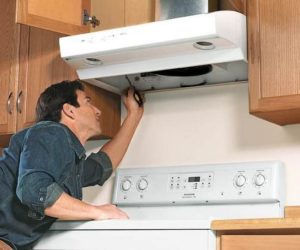 Installing a power source next to a suspended hood is the most common method of supplying electricity. It is convenient to make such a connection at the design stage of constructing kitchen walls. The structural condition of the walls makes it possible to install the electrical wire using a hidden method. With this arrangement, a hidden type electrical appliance is chosen.
Installing a power source next to a suspended hood is the most common method of supplying electricity. It is convenient to make such a connection at the design stage of constructing kitchen walls. The structural condition of the walls makes it possible to install the electrical wire using a hidden method. With this arrangement, a hidden type electrical appliance is chosen.
It is recommended to place the power source at a height of 20–40 cm from the working plane of the hood on the left or right side of the air duct. When choosing a side, ease of access to the electrical appliance is taken into account. Some craftsmen try to hide it behind the air duct so that the connection is not visible. But turning the hood on or off from the network with such an installation will be extremely inconvenient.Aesthetic perception fades into the background, especially in case of urgent need to switch off.
You can soften the visual perception of a power source located on the side of the hood. To do this, you need to pay due attention to its color and design when purchasing. This connection will be correct and safe.
In the case when you have to deal with installing a socket on already finished walls, external laying of the electrical wire and the use of a surface-mounted electrical device are applicable. Hidden installation is more correct, but if we are talking about a tiled wall, then there are no other options.
When laid open, in accordance with safety requirements, the electrical wire is mounted in a special plastic corrugated braid. This will prevent accidental damage to the electrical cable.
REFERENCE! The use of special plastic fasteners promotes smooth and clear installation of the electrical network.
It is possible to install using a combined method, i.e. hidden wiring and surface-mounted sockets or vice versa. Such a performance will not be pleasing to the eye, but will only be able to fulfill its intended purpose.
It is important to use an electrical wire with a cross-section of 2.5 sq. mm and a socket rated for 16 A. This will preserve the consumer connection network in the event of overloads or improper use. Most household hoods have an operating current of up to 10 A. But during voltage surges, the design of the electrical part must have a safety margin.
Installing a hood inside the top row of kitchen furniture will greatly simplify the method of connecting to the electrical network. With this design of ventilation equipment for the kitchen, it is important to supply voltage to the top row using a hidden or open method. To do this, they often use a pencil case located close to the top row of shelves.
Installation of electrical wiring inside the furniture will have to be done in a metal corrugation or a special fireproof plastic braid. The current source is installed in close proximity to the hood on the back or side wall of the cabinet.
In accordance with safety requirements, the surface-mounted socket must be installed on a fireproof base. As the latter, a dielectric plate is used that is larger in area than the base of the electrical appliance by 10–15 mm on each side.
Such a connection will be the best from an aesthetic point of view. The technical features of using such installation are less positive. Electrical wiring installed inside furniture made of wood or chipboard has a risk of fire. Strict adherence to the rules and regulations for laying household electrical networks will minimize this risk.
There are different methods for connecting ventilation equipment in domestic premises: with twists, through an automatic device or through a terminal block. Correct and safe in all respects is to connect the hood in the kitchen using a socket. Other methods have greater risks and less reliability.

